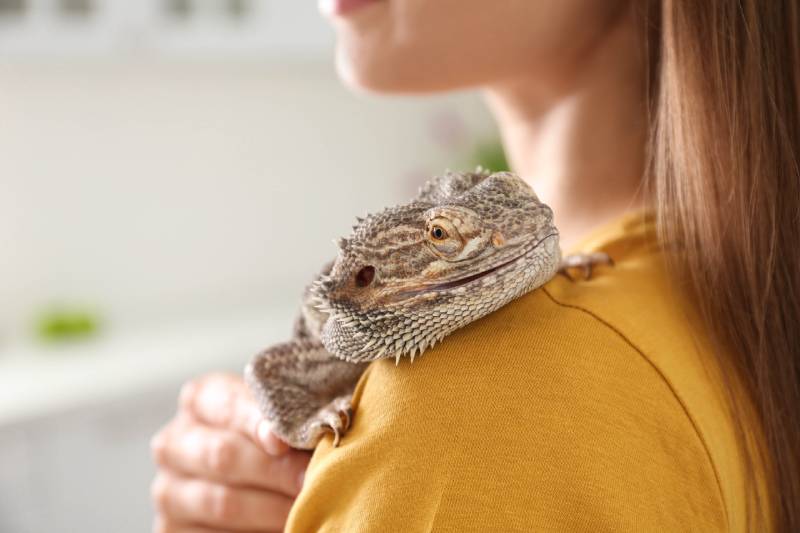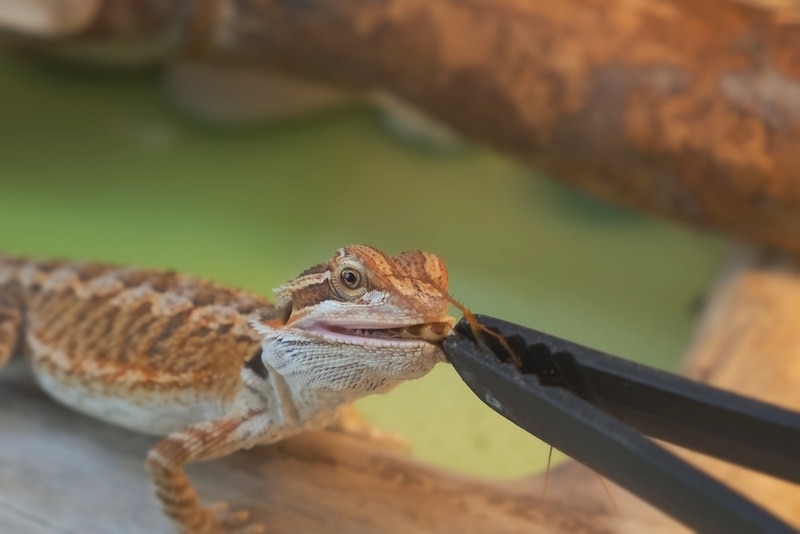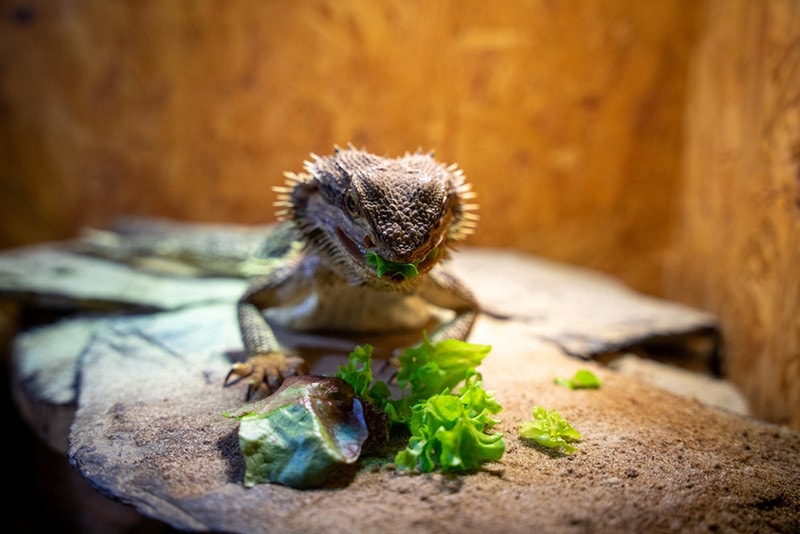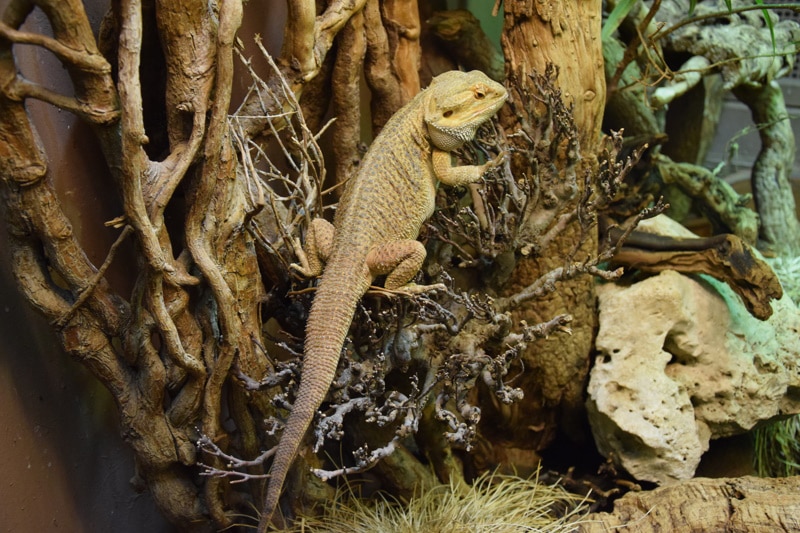How to Train Bearded Dragons: 6 Simple Steps
Updated on

What can a lizard do other than simply slither around? Well, quite a few things actually. The easiest thing to train your bearded dragon to do is to make it come to you. It’s somewhat similar to how you’d train a dog, but it isn’t as time-consuming as you may think.
Below, we give a step-by-step guide on training a bearded dragon. Once you’ve got the hang of it, you can train your pet to do several things. Let’s get started!
What You’ll Need
Before you start training a bearded dragon, you’ll need two things:
Prey
It’s the most important thing you need to train your pet lizard. You can buy insects or worms, depending on availability and preference. Worms are usually much easier to handle since they don’t move as much. However, do not overfeed your pet lizard super worms or other fatty prey. Excessive feeding can cause digestive issues in bearded dragons.
Treats
Treats are the additional incentive your pet needs to follow your commands. There are plenty of options to choose from, such as king worms, mealworms, and crickets. If you want to keep it healthy, opt for kale, pepper, sweet potatoes, and parsley.
The 6 Steps to Train a Bearded Dragon to Come to You
Once you’ve got all the training goods, you’re all set to follow these steps. Since training your bearded dragon to come to you is the easiest place to start, that’s what we’re going to aim for. However, you can use these steps for various other tricks.
1. Bond/Socialize With Your Pet Lizard
A bearded dragon will only be comfortable coming to you if it’s not scared of you. Start by bonding with your pet lizard. Sit close to your lizard’s enclosure when doing everyday activities. For example, you can read, use your phone, or watch TV next to your lizard.
You can also open your pet’s cage and let them roam around the house to get comfortable. Initially, the bearded dragon may be a bit skittish, but it will start exploring its surroundings if you don’t pay it much attention.
- No other animal or pet is in the area since it might see the bearded dragon as prey.
- The area is warm, as bearded dragons need external heat for temperature regulation.
- The bearded dragon does not go to the kitchen, as its skin has salmonella bacteria, which causes food contamination.
- No windows or doors are open through which the bearded dragon can escape.

2. Choose the Training Times
Select at least one training time per day. It should be the time before your pet eats. If the bearded dragon is hungry, it will likely come to you for food or treats. But don’t neglect your pet’s meal times to make them hungry.
3. Lure Your Bearded Dragon With Prey
Get the bearded dragon out of its cage and put it on the ground or a table close to you. Make sure there are no distractions near the bearded dragon.
Hold the prey, such as a worm, in your hand. Keep your hand in the lizard’s sight, but not so close that it can approach it without moving. When the bearded dragon sees food, it will start moving toward it.
Move your hand to bring it closer to your body. Hold the prey where you want the lizard to come, such as your knee. Let the lizard eat the worm when it comes to your desired place.

4. Repeat
Keep doing this with a few more worms for 10 minutes or until your bearded dragon is full. Repeat this every day for a few weeks. Ideally, you should do this practice daily. Don’t let there be a gap of more than 2 days in between.
5. Use Treats
After practicing with prey for a few days, switch to treats. Use healthy treats, such as veggies, to ensure your pet doesn’t get sick. The bearded dragon might be reluctant at first when you move from delicious fatty prey to veggies. But give it some time and it will eventually come around.

6. Reduce Treats
By now, your bearded dragon should come to you as soon as it sees treats. Now, it’s time to reduce treats until you remove them completely.
First, reduce the number of times you give treats by one. For example, if you previously gave five treats per training practice, give only four now. A few days later, reduce it to two treats per practice. Then, give only one treat per practice.
After you remove the treats from the training practice gradually, your bearded dragon will come to you on command. You just have to make the feeding shape with your hand. Motion the bearded dragon to you just as you did when feeding it.
By this time, the lizard has started associating these motions and your scent with the positive experience of being fed. So, it will come to you whenever it senses the same.
How to Train Your Bearded Dragon to Be Handled
Does your bearded dragon scurry away when you try to hold it? You may be doing it wrong.
To pick up your pet lizard, you should move your hand toward its body from the front or the side. Scoop it up in your hand using a single movement.
Support your bearded dragon’s whole body when you hold it. That includes the tail and legs.
- Do not hold your bearded dragon from its behind. It might think you’re a predator and bite you.
- Do not pick up a bearded dragon with its tail. While other lizards may be able to regenerate their tails, bearded dragons cannot. If you harm your pet’s tail, it will not come back.
When you pick up a bearded dragon, hold it for about 10 minutes. Frequent contact will allow your pet to associate human touch with safety. But don’t overdo it. Bearded dragons can get aggressive if you hold them for long periods. Have short handling sessions of 10 minutes multiple times a day instead of a long one-hour session.

Conclusion
Training a bearded dragon to do anything requires patience and a lot of prey or treats. The initial step is to socialize your pet lizard.
After it stops seeing you as a threat, you can train it to come to you or poop in a certain area. Bearded lizards are intelligent animals and pick up habits quickly, but you may have to spend a few weeks teaching your pet lizard a new habit.
Featured Image Credit: New Africa, Shutterstock











